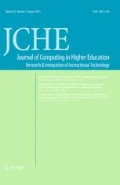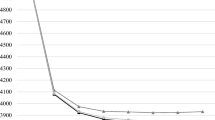Abstract
This study addressed some of the challenges of supporting self-regulated learning in community college online English composition. This course used a flexible learning design, providing a choice of procedural scaffolds to support self-regulation of learning tasks by students. The purpose of this study was to determine the relationship between the use of two procedural scaffolds, a custom-designed, interactive checklists tool and a non-interactive calendar tool, and the core assignment submission and metacognition of online English composition students. Measures included clickstream data for procedural scaffold usage, a count of core assignment submissions, and Metacognitive Awareness Inventory scores. Results indicated that use of the custom-designed interactive checklists tool better supported submission of core assignments by students than the non-interactive calendar tool. While metacognition awareness scores increased across the study, no significant association with procedural scaffold use was found. Implications for future practice support the continued and extended use of interactive procedural scaffolds to support online students through task completion for complex processes such as academic writing.



Similar content being viewed by others
References
Alexander, P. A., Kulikowich, J. M., & Jetton, T. L. (1994). The role of subject-matter knowledge and interest in the processing of linear and nonlinear texts. Review of Educational Research, 64, 201–252.
Allen, I. E., & Seaman, J. (2013). Changing course: Ten years of tracking online education in the United States. Babson Survey Research Group and Quahog Research Group, LLC, Oakland, CA. Retrieved from http://www.onlinelearningsurvey.com/reports/changingcourse.pdf.
Atwell, N. (1987). In the middle: Writing, reading, and learning with adolescents. Portsmouth, NH: Boynton/Cook.
Azevedo, R., Cromley, J., Moos, D., Greene, J., & Winters, F. (2011). Adaptive content and process scaffolding: A key to facilitating students’ self-regulated learning with hypermedia. Psychological Test and Assessment Modeling, 53(1), 106–140.
Bandura, A. (1989). Regulation of cognitive processes through perceived self-efficacy. Developmental Psychology, 25, 725–739.
Belland, B. R. (2014). Scaffolding: Definition, current debates, and future directions. In J. M. Spector et al. (Eds.), Handbook of research on educational communications and technology (pp. 505–518). New York: Springer.
Belland, B. R., Kim, C., & Hannafin, M. J. (2013). A framework for designing scaffolds that improve motivation and cognition. Educational Psychologist, 48(4), 243–270. doi:10.1080/00461520.2013.838920.
Bendixen, L. D., & Hartley, K. (2003). Successful learning with hypermedia: The role of epistemological beliefs and metacognitive awareness. Journal of Educational Computing Research, 28(1), 15–30. (Retrieved from Education Full Text).
Bergamin, P. B., Werlen, E., Siegenthaler, E., & Ziska, S. (2012). The relationship between flexible and self-regulated learning in open and distance universities. International Review of Research in Open & Distance Learning, 13(2), 101–123. (Retrieved from Education Full Text).
Bonwell, C., & Sutherland, T. (1996). The active learning continuum: Choosing activities to engage students in the classroom. New Directions for Teaching and Learning, 67, 3–16. (Retrieved from Wiley Online Library).
Bransford, J., Brown, A., & Cocking, R. (Eds.) National Research Council (US)/Committee on Learning Research and, Educational Practice, & National Research Council (US)/Committee on Developments in the Science of Learning. (2000). How people learn: Brain, mind, experience, and school expanded ed. United States of America: National Academy Press.
Braun, V., & Clarke, V. (2006). Using thematic analysis in psychology. Qualitative Research in Psychology, 3(2), 77–101.
Butler, D. L., & Winne, P. H. (1995). Feedback and self-regulated learning: A theoretical synthesis. Review of Educational Research, 65, 245–281. (Retrieved from Education Full Text).
Chen, S. Y., Fan, J.-P., & Macredie, R. D. (2006). Navigation in hypermedia learning systems: Experts versus novices. Computers in Human Behavior, 22, 251–266.
Clark, R. C., & Mayer, R. E. (2003). E-learning and the science of instruction. San Francisco: Jossey-Bass Pfeiffer.
Creswell, J. W. (2014). Qualitative inquiry and research design: Choosing among five approaches. Thousand Oaks, CA: Sage.
Dabbagh, N., & Kitsantas, A. (2005). Using web-based pedagogical tools as scaffolds for self-regulated learning. Instructional Science, 33(5), 513–540. doi:10.1007/s11251-005-1278-3.
De Jong, T., & van der Hulst, A. (2002). The effects of graphical overviews on exploratory behaviour and knowledge acquisition in hypertext environments. Journal of Computer Assisted learning, 18, 219–232.
Dillenbourg, P. (2002). Over-scripting CSCL. In P. A. Kirschner (Ed.), Three worlds of CSCL: Can we support CSCL (pp. 61–91). Heerlen: Open University of the Netherlands.
Duffy, T. M., & Cunningham, D. J. (1996). Constructivism: implications for the design and delivery of instruction. In D. Jonassen (Ed.), Handbook of research on educational communications and technology (1st ed., pp. 1–31). New York, NY: Routledge/Taylor & Francis Group.
Dunlap, L. K., & Dunlap, G. (1989). A self-monitoring package for teaching subtraction with regrouping to students with learning disabilities. Journal of Applied Behavior Analysis, 22, 309–314.
Fleiss, J. L., Levin, B., & Paik, M. C. (2003). Statistical methods for rates and proportions. New York: Wiley.
Glaser, C., & Brunstein, J. (2007). Improving fourth-grade students’ composition skills: Effects of strategy instruction and self-regulation procedures. Journal of Educational Psychology, 99(2), 297–310.
Goldrick-Rab, S. (2010). Challenges and opportunities for improving community college student success. Review of Educational Research, 80(3), 437–469. doi:10.3102/0034654310370163.
Greene, J. A., & Azevedo, R. (2007). A theoretical review of Winne and Hadwin’s model of self-regulated learning: New perspectives and directions. Review of Educational Research, 77(3), 334–372. doi:10.3102/003465430303953.
Grotzer, T. A. (2002). Expanding our vision for educational technology: Procedural, conceptual, and structural knowledge. Educational Technology, 42(2), 52–59. (Retrieved from Education Full Text).
Henry, J., & Meadows, J. (2008). An absolutely riveting online course: Nine principles for excellence in web-based teaching. Canadian Journal of Learning And Technology/La Revue Canadienne De L’Apprentissage Et De La Technologie, 34(1). Retrieved from http://www.cjlt.ca/index.php/cjlt/article/view/179/177.
Hill, J. R., & Hannafin, M. J. (2001). Teaching and learning in digital environments: The resurgence of resource-based learning. Educational Technology Research and Development, 49(3), 37–52. doi:10.1007/BF02504914.
Hmelo-Silver, C. E. (2006). Design principles for scaffolding technology-based inquiry. In A. M. O’Donnell, C. E. Hmelo-Silver, & G. Erkens (Eds.), Collaborative reasoning, learning and technology (pp. 147–170). Mahwah, NJ: Erlbaum.
Hung, D. (2001). Theories of learning and computer-mediated instructional technologies. Educational Media International, 38(4), 281–287. doi:10.1080/09523980110105114.
Jonassen, D. H., & Wang, S. (1993). Acquiring structural knowledge from semantically structured hypertext. Journal of Computer-Based Instruction, 20(1), 1–8. (Retrieved from Education Full Text).
Kim, M., & Hannafin, M. J. (2011). Scaffolding problem solving in technology-enhanced learning environments (TELEs): Bridging research and theory with practice. Computers & Education, 56(2), 403–417. doi:10.1016/j.compuedu.2010.08.024.
Latham, G. P., & Locke, E. A. (1991). Self-regulation through goal setting. Organizational Behavior and Human Decision Processes, 50(2), 221–247. doi:10.1016/0749-5978(91)90021-K.
Lawless, K. A., & Brown, S. W. (1997). Multimedia learning environments: Issues of learner control and navigation. Instructional Science, 25, 117–131.
Locke, E., & Latham, G. (2002). Building a practical useful theory of goal setting and task motivation: A 35 year odyssey. American Psychologist, 57(9), 705–717. doi:10.1037/0003-066X.57.9.705.
Manlove, S., Lazonder, A. W., & de Jong, T. (2007). Software scaffolds to promote regulation during scientific inquiry learning. Metacognition & Learning, 2(2), 141–155. doi:10.1007/s11409-007-9012-y.
Miles, M. B., & Huberman, A. M. (1994). Qualitative data analysis. Thousand Oaks, CA: Sage Publications.
Miller, R. B., Behrens, J. T., & Greene, B. A. (1993). Goals and perceived ability: Impact on student valuing, self-regulation, and persistence. Contemporary Educational Psychology, 18, 2–14. doi:10.1006/ceps.1993.1002.
Mills, R. J., Paper, D., Lawless, K. A., & Kulikowich, J. M. (2002). Hypertext navigation—An intrinsic component of the corporate intranet. Journal of Computer Information Systems, 42, 49–50.
Moos, D., & Azevedo, R. (2006). The role of goal structure in undergraduates’ use of self-regulatory processes in two hypermedia learning tasks. Journal of Educational Media and Hypermedia, 15(1), 49–86. (Retrieved from Education Full Text).
Murray, D. M. (1978). Teach the motivating force of revision. The English Journal, 67(7), 56–60. Retrieved from http://www.jstor.org/stable/814742.
Niederhauser, D. S., Reynolds, R. E., Salmen, D. L., & Skolmoski, P. (2000). The influence of cognitive load on learning from hypertext. Journal of Educational Computing Research, 23, 237–255.
Pintrich, P. R. (2004). A conceptual framework for assessing motivation and self-regulated learning in college students. Educational Psychology Review, 16(4), 385–407. doi:10.1007/s10648-004-0006-x.
Potelle, H., & Rouet, J.-F. (2003). Effects of content representation and readers’ prior knowledge on the comprehension of hypertext. International Journal of Human–Computer Studies, 58, 327–345.
Proske, A., Narciss, S., & Korndle, H. (2007). Interactivity and learners’ achievement in web-based learning. Journal of Interactive Learning Research, 18(4), 511–531.
Reiser, B. J. (2004). Scaffolding complex learning: The mechanisms of structuring and problematizing student work. Journal of the Learning Sciences, 13(3), 273–304. doi:10.1207/s15327809jls1303_2.
Saldaña, J. (2013). The coding manual for qualitative researchers. Los Angeles: SAGE Publications.
Scheiter, K., & Gerjets, P. (2007). Learner control in hypermedia environments. Educational Psychology Review, 19, 285–307. doi:10.1007/s10648-007-9046-3.
Schraw, G., & Dennison, R. S. (1994). Assessing metacognitive awareness. Contemporary Educational Psychology, 19(4), 460–475. Retrieved from https://docs.google.com/file/d/0B2nKniiL1qBzLTE4UzVvaVVqeEk/edit.
Shea, P., & Bidjerano, T. (2014). Does online learning impede degree completion? A national study of community college students. Computers & Education, 75(0), 103–111. Retrieved from http://dx.doi.org/10.1016/j.compedu.2014.02.009.
Song, L., & Hill, J. R. (2009). Understanding adult learners’ self-regulation in online environments: A qualitative study. International Journal of Instructional Media, 36(3), 263–274. (Retrieved from Education Full Text).
Spiro, R. J., Collins, B. P., Thota, J. J., & Feltovich, P. J. (2003). Cognitive flexibility theory: Hypermedia for complex learning, adaptive knowledge application, and experience acceleration. Educational Technology, 44(5), 5–10.
Spiro, R. J., & Jehng, J. C. (1990). Cognitive flexibility and hypertext: Theory and technology for the nonlinear and multidimensional traversal of complex subject matter. In D. Nix & R. J. Spiro (Eds.), Cognition, education, and multimedia (pp. 163–205). Hillsdale, NJ: Erlbaum.
Stegmann, K., Mu, J., Gehlen-Baum, V., & Fischer, F. (2011). The myth of over-scripting: Can novices be supported too much? In H. Spada, G. Stahl, N. Miyake, & N. Law (Eds.), Connecting computer-supported collaborative learning to policy and practice: CSCL2011 conference proceedings (vol 1, pp. 406–413).
The College Board. (2014). Accuplacer program manual. New York: The College Board.
Whipp, J. L., & Chiarelli, S. (2004). Self-regulation in a web-based course: A case study. Educational Technology Research and Development, 52(4), 5–22. doi:10.1007/BF02504714.
Winne, P. (2011). A cognitive and metacognitive analysis of self-regulated learning. In B. Zimmerman & D. Schunk (Eds.), Handbook of self-regulation and performance (pp. 15–32). New York: Routledge.
Wood, D., Bruner, J. S., & Ross, G. (1976). The role of tutoring in problem solving. Journal of Child Psychology and Psychiatry, 17(2), 89–100. Retrieved from http://onlinelibrary.wiley.com/doi/10.1111/j.1469-7610.1976.tb00381.x/pdf.
Zimmerman, B. J. (1989). A social cognitive view of self-regulated academic learning. Journal of Educational Psychology, 81, 329–339.
Zimmerman, B. J., & Kitsantas, A. (1997). Developmental phases in self-regulation: Shifting from process goals to outcome goals. Journal of Educational Psychology, 89(1), 29–36. doi:10.1037/0022-0663.89.1.29.
Zimmerman, B. J., & Pons, M. M. (1986). Development of a structured interview for assessing student use of self-regulated learning strategies. American Educational Research Journal, 23(4), 614–628. doi:10.2307/1163093.
Author information
Authors and Affiliations
Corresponding author
Ethics declarations
Conflict of interest
The authors declare that they have no conflict of interest.
Rights and permissions
About this article
Cite this article
Kellen, K., Antonenko, P. The role of scaffold interactivity in supporting self-regulated learning in a community college online composition course. J Comput High Educ 30, 187–210 (2018). https://doi.org/10.1007/s12528-017-9160-2
Published:
Issue Date:
DOI: https://doi.org/10.1007/s12528-017-9160-2



